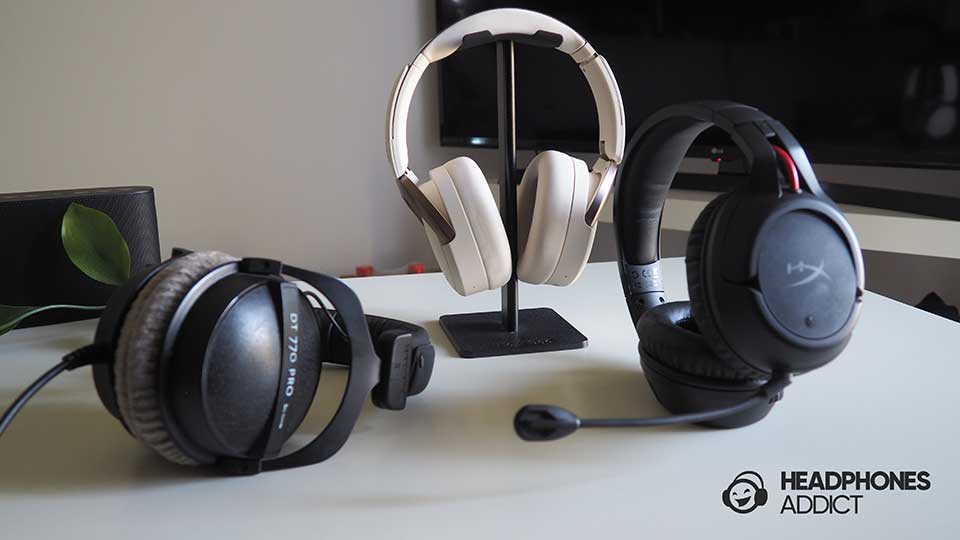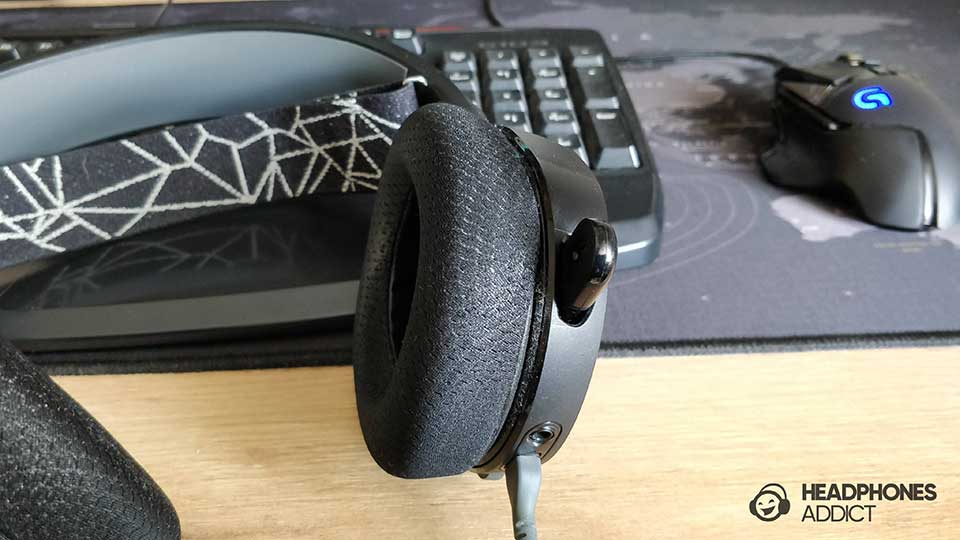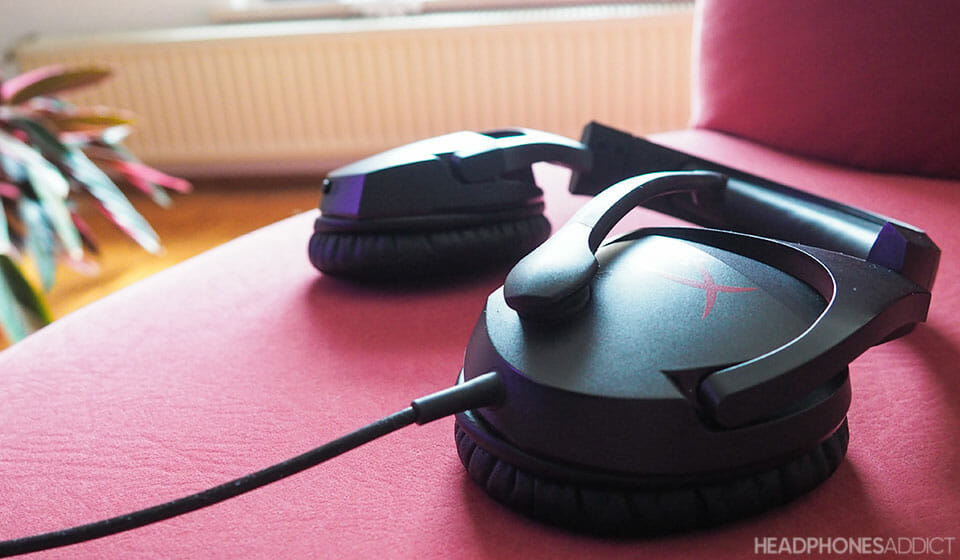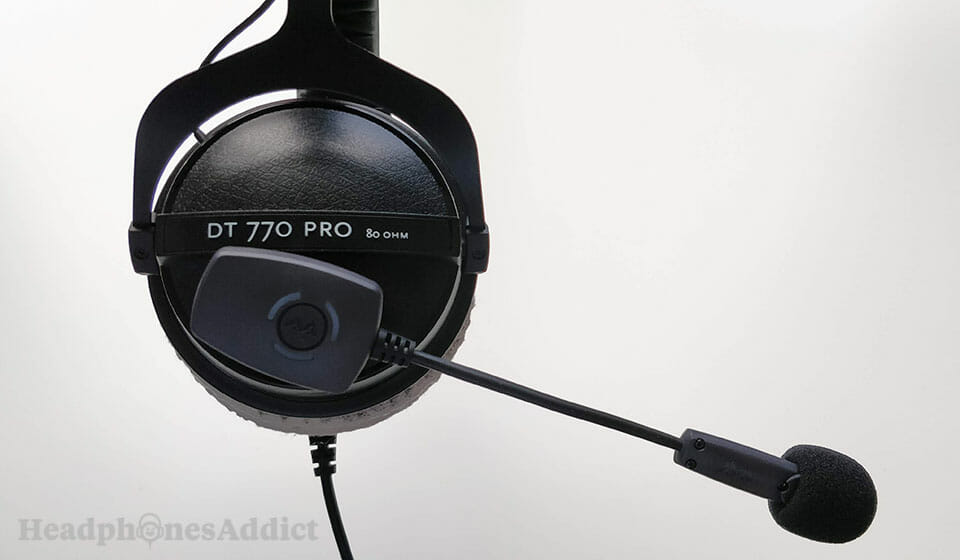Quick answer: A headset is headphones with a microphone for calls. But it’s not that simple. It affects numerous things we’ll discuss in this article.
Learn all the differences and find out which type is the best for you.

Quick Comparison Between Headsets and Headphones
| Headsets | Headphones | |
|---|---|---|
| What can you do with them? | Listen to audio, music, videos, movies, games, etc. | Listen to audio, music, videos, movies, games, etc. |
| Do they have a mic? | One or more microphones | No microphone |
| Can they make calls? | Perfect for calls, video calls, Zoom calls, Skype, etc. | Can’t make calls |
| Can they have ANC? | Can use microphones for ANC (active noise cancellation) | Can’t support ANC due to lack of microphones |
| Are they big? | Usually bulkier (with a boom mic) | Both sleek and bulky types |
| Can they sound audiophile? | Headsets are rarely considered “audiophile” | All audiophile headphones are over-ear headphones |
As the name suggests, a headset is a set of headphones (for listening) and a microphone (for talking).
Headset vs. Headphones: Which Should You Buy?
A headset with a microphone gives you access to more features that regular headphones don’t have. However, both have pros and cons.
Note: The majority of wireless Bluetooth headphones are technically headsets. But most people call them “headphones” out of habit. While “headset” is primarily understood as headphones with a boom microphone, e.g., gaming headsets.
You should buy a headset if …

1. You need a microphone
You need a microphone for:
- Playing online games
- Work calls and video conferences
- Chatting with friends
- Having phone calls over a headset
You can buy a standalone mic for your gaming needs, but unless you’re a professional streamer, an integrated microphone is more than good enough.
2. You want active noise cancelling (ANC)
All ANC headphones require microphones to work.
So, while most ANC models are called “headphones,” the correct naming would be “ANC headsets.”
Microphones also support extra features. Features like ambient sound mode and smart assistants.
You should buy headphones if …

1. You don’t need a built-in mic
If having a microphone isn’t important or you already have a standalone mic, buying a headset isn’t necessary.
Also, if you plan to use them at home, ANC isn’t that useful.
2. You want higher sound quality
There are no high-end headsets (apart from professional broadcaster ones), whereas all audiophile cans are headphones.
3. You want longevity/durability
Headphones are more basic in functionality, so fewer parts could break or malfunction. Consequently, they last longer.
Headset vs. Headphones: Differences by Category
We’ve glanced over the main differences between the two types. Now let’s go into more detail about why one is better than the other.
Sound quality
As mentioned above, all audiophile models are headphones, not headsets.

But to avoid confusion: that doesn’t mean all headsets have worse sound quality than headphones.
It’s not that you shouldn’t buy headsets if you want audio quality. However, buying a headphone is the only option if you want top-of-the-line audio performance.
It is not that headsets can’t sound great. But if you want top of the line audio quality, you must resort to headphones.
Comfort and ergonomics
For the most part, there’s zero difference between headphones and headsets in terms of comfort and ergonomics.
Most headsets, especially wireless Bluetooth ones, have microphones discretely built into the cups, so they don’t add to the bulk.
On the flip side, gaming headsets have boom microphones that stick out from one side of the headset. It doesn’t affect comfort. But may affect ergonomics in some models.
Use cases and applications
The biggest difference between headsets and headphones is in how and where you use them.
Headphones
- Regular headphones are best for music listening or professional work in studios.
- They’re perfect for enjoying multimedia content like movies or listening to audiobooks.
- Best for listening without extra features.
Headsets
- Headsets are best used when you expect to make calls, like in the office, for video conferencing, homeschooling, or online gaming.
- They’re the only option to reduce background noise using ANC on public transport, during traveling, etc.
- Headsets are best for everyday use thanks to their versatility.

Noise cancellation and isolation
ANC needs microphones. Knowing a little about how ANC works, you need at least 1 microphone to capture ambient sound and to do the “noise cancelling magic”—more on that in how ANC works.
So, for headphones to implement active noise cancelling technology, they must have a microphone. Which technically makes them a headset. This technically means no headphones can have ANC. Though we still call them that.
Sure, some obscure models like QuietOn sleep earbuds have ANC (they have a mic) but can’t reproduce music or receive phone calls. So, they’re technically headphones with ANC.
Connectivity
Connection-wise, headphones are mostly wired. While headsets are mostly wireless using Bluetooth.
We have yet to see over-ear headphones with wireless connectivity that lack a microphone.
Headphone manufacturers decided that making wireless headphones without the ability to answer calls isn’t an option. Therefore, all wireless Bluetooth over-ears are headsets.

Design and form factor
Headphones are often built to showcase luxurious materials and provide maximum comfort, whereas headsets are usually made of plastic to keep the weight down. Some also have a big attached mic to their earcups.
Headphones
Headphones can be:
- Over-ear
- In-ear
- On-ear
- Closed-back
- Open-back
You can find all types of headphones when it comes to materials and size.
They can be entirely plastic or use luxurious building materials such as wood, carbon fiber, and different types of metal, not just aluminum.
Depending on driver size and cushioning, they can be slim or bulky.
The cable can be detachable or fixed, but they always use an analog plug (3.5mm, 6.35mm, etc.).
Headsets
Headsets can be:
- Over-ear
- In-ear
- On-ear
- Closed-back
- Open-back (although rarely, to avoid the audio creeping into the microphone)
- Mono-ear
Headsets use various construction materials but are generally plastic to keep weight down.
They can have a detachable cable, usually with a 4-pole connector (or double 3-pole) instead of single 3-poles for microphone signal. And some headsets use a single USB plug for audio and microphone signal.

Manufacturers decide on different ways to implement a microphone inside a headset. You can have a:
- Boom microphone with an arm that extends towards your mouth. The arm can be retractable, detachable, or flippable (flips up). Boom mic headsets are common in offices and gaming headsets where voice quality is a priority.

- A built-in microphone is hidden inside an inline module or in the earcup. All Bluetooth headsets including true wireless earbuds have a built-in microphone.

Furthermore, the first-ever Bluetooth headphones were a mono headset that you put on your ear, and answered calls while doing other things.
Pricing and budget
You can find headphones and headsets at all price ranges. Generally, headphones can be more expensive than headsets.
If the price for headsets maxes out below $1,000, the price for ultra-premium headphones can go as high as $50,000. See the most expensive headphones list.
The reason for that is:
- Headsets target a wider audience and specific occupations that want a microphone in a bundle, so they have to offer more at an attractive price. Therefore, they need to take some shortcuts.
- Headphones primarily sell sound quality, so they need to be as masterful as possible at it. Using various driver types, careful tuning, and expensive materials to give a luxurious experience increases the price. However, diehard audiophiles are willing to pay anything to get the best sound quality.
Gaming performance and features
Headsets have more features.
Because headsets can do more things, manufacturers keep implementing new features that improve user experience.
For instance:
- Gaming headsets typically support virtual surround sound, either the manufacturer’s version or from DTS or Dolby.
- Office headsets have stronger noise reduction technology and other features that clear your voice.
- Almost all Bluetooth headsets around $100 now arrive with active noise cancellation and ambient sound mode.
Headphones are more basic.
Headphones have less features. The most they usually offer is removable cable.
However, you can use regular open-back headphones for gaming for a wider sound stage that increases immersion. You need a standalone mic or add-on like the Antlion ModMic Wireless.

Headset vs. Earphones
- A headset consists of headphones and a microphone.
- Earphones are a smaller type of headphones like earbuds or in-ear headphones, but they don’t go into your ear canal.
This means earphones can also be a headset.
Many true wireless earphones that don’t go in the ear, have a microphone.
For example, SoundPEATS Air4 are true wireless earphones and headsets because they have a built-in microphone.

You can use smaller headsets the same way as full-sized ones. They’re good for making phone calls, video calls, and even gaming. But not so good for active noise cancelling due to lack of passive isolation.
Earbuds and in-ear monitors (IEMs) that go into your ear canal are much better headsets due to passive noise isolation.
Antlion Kimura Solo is a gaming headset with a detachable boom mic.

Related:
FAQ: Frequently Asked Questions About Headsets and Headphones
What is the difference between headset and headphone?
The difference between headset and headphone is that a headset has a microphone, attached or built-in, whereas a headphone doesn’t have a microphone.
Are headsets better than headphones?
Headsets are better than headphones by offering more features, like receiving and answering calls, active noise cancellation, transparency mode, and voice assistants. On the other hand, headphones typically output better sound quality.
What is the difference between headphones, headsets, and earphones?
The key difference between headphones, headsets, and earphones is that headphones don’t have a mic, headsets have a mic, and earphones are earbuds that don’t go in ear, but can either have a mic or not.
Can you use headphones as a headset?
No, you can’t use headphones as a headset without add-ons. However, you can adapt headphones to become a headset by mounting a separate microphone add-on or changing the cable with one that has an inline built-in mic.
Are headsets better for gaming?
Headsets are better for gaming if you like playing and chatting with friends. Also, gaming headsets typically come with virtual surround sound for a more immersive listening experience. That said, some regular headphones can have a huge soundstage and more detailed sound, increasing immersion.
Conclusion
Hopefully, you now understand headsets and headphones inside out. And you can make an educated decision on which type suits you. To recap:
- If you plan to make calls by phone, video, or during online matches with your friends, you should pick the best headset with a mic. Sure, you can adapt headphones to become headsets, but the extra expense isn’t worth it for most people.
- Pick the best audiophile headphones if you focus primarily on music and don’t care about the extra features a microphone brings. As mentioned, you can later buy a separate microphone if needed.

From a childhood fascination with sound, Peter’s passion has evolved into a relentless pursuit of the finest headphones. He’s an audio expert with over 5 years of experience in testing both audiophile and consumer-grade headphones. Quote: “After many years, I can confidently tell which headphones are good and which are terrible.” Find his honest opinion in his reviews.



